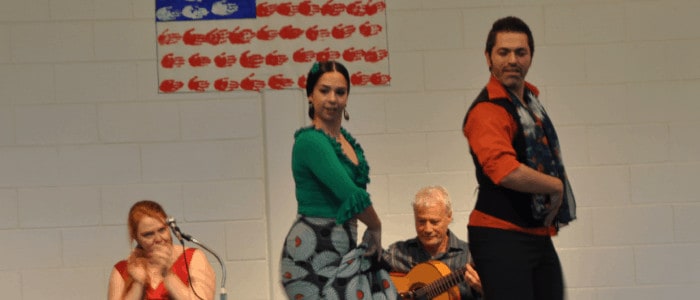The excitement builds at J.S. Waters School as students eagerly await their performance. They’re sitting in neat rows on the floor, not exactly sure of what they’re here to see, but sure they’ve taken a mini field trip – a break from their normal routine – so something exciting must be about to take place. Then the Spanish dance company, Flamenco Vivo Carlota Santana, steps out onto the stage and begins performing. The music of the lone guitar and castanets fill the air as a story unfolds, both through song and spoken word. This is the Flamenco Vivo Carlota Santana Artists-in-Schools Initiative, powered by Monteith, and boy! are these fourth through sixth graders in for a treat.

What exactly is Flamenco? To be sure, it’s not the same as “flamingo”! “Flamenco is an incredible mix of many different cultures coming together,” explains Meagan Chandler, the artist who wrote the play that she, and the dance company, will be performing. “Flamenco is also very creative, expressive, and collaborative.” Flamenco is typically defined as a highly expressive form of song and dance that incorporates hand clapping, percussive instruments (like castanets), and guitar. Around 50% of the students in this school do not have access to the internet at home, so watching and learning an international dance form is not something they would ordinarily be exposed to–in person or even on a screen.
This day, Flamenco Vivo Carlota Santana tell the story of Chicco and the golden key using simple instructions to engage the audience, all the while teaching them basic techniques of Flamenco. “Move your arm as if you’re picking an apple from a tree. Take a flower and put it in your pocket.” The students do exactly as they’re told and little by little, they start to see the elements of this ancient dance form come together.



After the performance, students are eager to ask questions about Flamenco, the performers, and how this all came to be. Little do they know, but a pop-quiz is heading their way. Now it’s the performers’ turn to ask them questions about the story that unfolded through the beautiful art form of Flamenco. Luckily, the students’ rapt attention pays off as they shout out the answers to each and every question proudly.
This is not the end of J.S. Waters’ experience. Next comes individual class workshops where the performers weave social studies, English language arts, and Spanish into interactive and engaging exercises. “We are talking about Spaniards coming into the US in our history lesson, and this performance shows the Spanish connection to our culture,” explained Tracy Spaulding, fourth grade teacher.

Each class learns an entire Flamenco performance, complete with Spanish song. Much of the dance is created on the spot, with the help of the students. The performers ask the students to divide into groups based on the number of syllables in their names. For each group, a new dance step is made up to match the number of syllables. AL-EX-AN-DRA! Then, they put all the dance steps and songs they’ve learned together, and voila!, they’re ready to perform.




The Chatham Arts Council could not bring professional artists into Chatham County schools without the help of our partners: Chatham County Schools, Chatham County, and the North Carolina Arts Council.
A HUGE thank you to Monteith for powering this initiative at J.S. Waters–and to Principal Chris Bowling, the teachers, and the students for a warm welcome!
The Chatham Arts Council is working to expand the Artists-in-Schools Initiative this year, bringing professional artists into 13 Chatham County schools. Click here to be part of this artistic endeavor.


Leave a Reply